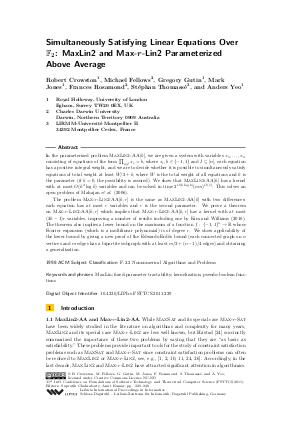Simultaneously Satisfying Linear Equations Over F_2: MaxLin2 and Max-r-Lin2 Parameterized Above Average
Authors Robert Crowston, Michael Fellows, Gregory Gutin, Mark Jones, Frances Rosamond, Stéphan Thomassé, Anders Yeo
-
Part of:
Volume:
IARCS Annual Conference on Foundations of Software Technology and Theoretical Computer Science (FSTTCS 2011)
Part of: Series: Leibniz International Proceedings in Informatics (LIPIcs)
Part of: Conference: IARCS Annual Conference on Foundations of Software Technology and Theoretical Computer Science (FSTTCS) - License:
 Creative Commons Attribution-NonCommercial-NoDerivs 3.0 Unported license
Creative Commons Attribution-NonCommercial-NoDerivs 3.0 Unported license
- Publication Date: 2011-12-01
File

PDF
LIPIcs.FSTTCS.2011.229.pdf
- Filesize: 0.48 MB
- 12 pages
Document Identifiers
Subject Classification
Keywords
- MaxLin
- fixed-parameter tractability
- kernelization
- pseudo-boolean functions
Metrics
- Access Statistics
-
Total Accesses (updated on a weekly basis)
0Document
0Metadata
Abstract
In the parameterized problem MaxLin2-AA[$k$], we are given a system with variables x_1,...,x_n consisting of equations of the form Product_{i in I}x_i = b, where x_i,b in {-1, 1} and I is a nonempty subset of {1,...,n}, each equation has a positive integral weight, and we are to decide whether it is possible to simultaneously satisfy equations of total weight at least W/2+k, where W is the total weight of all equations and k is the parameter (if k=0, the possibility is assured). We show that MaxLin2-AA[k] has a kernel with at most O(k^2 log k) variables and can be solved in time 2^{O(k log k)}(nm)^{O(1)}. This solves an open problem of Mahajan et al. (2006).
The problem Max-r-Lin2-AA[k,r] is the same as MaxLin2-AA[k] with two
differences: each equation has at most r variables and r is the second parameter. We prove a theorem on Max-$r$-Lin2-AA[k,r] which implies that Max-r-Lin2-AA[k,r] has a kernel with at most (2k-1)r variables, improving a number of results including one by Kim and Williams (2010). The theorem also implies a lower bound on the maximum of a function f that maps {-1,1}^n to the set of reals and whose Fourier expansion (which is a multilinear polynomial) is of degree r. We show applicability of the lower bound by giving a new proof of the Edwards-Erdös bound (each connected graph on n vertices and m edges has a bipartite subgraph with at least m/2 +(n-1)/4 edges) and obtaining a generalization.
Cite As Get BibTex
Robert Crowston, Michael Fellows, Gregory Gutin, Mark Jones, Frances Rosamond, Stéphan Thomassé, and Anders Yeo. Simultaneously Satisfying Linear Equations Over F_2: MaxLin2 and Max-r-Lin2 Parameterized Above Average. In IARCS Annual Conference on Foundations of Software Technology and Theoretical Computer Science (FSTTCS 2011). Leibniz International Proceedings in Informatics (LIPIcs), Volume 13, pp. 229-240, Schloss Dagstuhl – Leibniz-Zentrum für Informatik (2011)
https://doi.org/10.4230/LIPIcs.FSTTCS.2011.229
BibTex
@InProceedings{crowston_et_al:LIPIcs.FSTTCS.2011.229,
author = {Crowston, Robert and Fellows, Michael and Gutin, Gregory and Jones, Mark and Rosamond, Frances and Thomass\'{e}, St\'{e}phan and Yeo, Anders},
title = {{Simultaneously Satisfying Linear Equations Over F\underline2: MaxLin2 and Max-r-Lin2 Parameterized Above Average}},
booktitle = {IARCS Annual Conference on Foundations of Software Technology and Theoretical Computer Science (FSTTCS 2011)},
pages = {229--240},
series = {Leibniz International Proceedings in Informatics (LIPIcs)},
ISBN = {978-3-939897-34-7},
ISSN = {1868-8969},
year = {2011},
volume = {13},
editor = {Chakraborty, Supratik and Kumar, Amit},
publisher = {Schloss Dagstuhl -- Leibniz-Zentrum f{\"u}r Informatik},
address = {Dagstuhl, Germany},
URL = {https://drops.dagstuhl.de/entities/document/10.4230/LIPIcs.FSTTCS.2011.229},
URN = {urn:nbn:de:0030-drops-33416},
doi = {10.4230/LIPIcs.FSTTCS.2011.229},
annote = {Keywords: MaxLin, fixed-parameter tractability, kernelization, pseudo-boolean functions}
}
